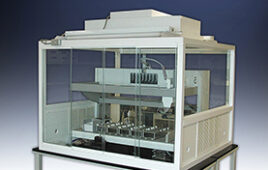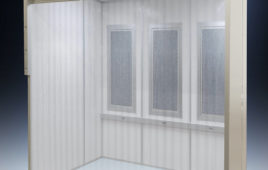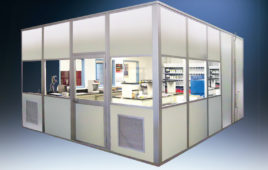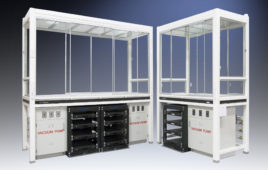Chemical Mechanical Planarization (CMP) slurry systems have created many new challenges in the semiconductor fabrication industry. Certain types of CMP slurries consisting of suspended solids in solution are abrasive, and traditional components used in wet process systems, such as diaphragm valves, can damage these slurries. If abrasive slurry is utilized in CMP plumbing, two key problems can occur—the premature failure of valve components and potential wafer damage.
Slurry damage resulting from improper valve selection is compounded by the negative effect of the slurry on the valve. Flow paths inside diaphragm valves can cause cohesion of the particles, increasing the size, thus causing a potentially damaging situation for wafers. Over time, valve diaphragms will become weakened in slurry applications, leading to the reduction of pressure resistance or to premature failure.
It seemed, at one time, that all wet process tools utilized diaphragm valves, regardless of whether they would transport DI water or pure chemicals. Diaphragm valves have many benefits such as a lack of seals, 100% PTFE or PFA design, and clean operation. However, when they are used in CMP slurry processes, problems begin to occur.
With the potential hazards of abrasive slurry, equipment manufacturers and consumers have begun to consider alternatives to diaphragm valves. The tests and information presented below provide evidence to the problems of using standard diaphragm valves in CMP applications, and the benefits of using pinch valves and multiport valves a better alternative solution.
To evaluate the suitability of the diaphragm valve for CMP applications, cycle testing was conducted. Figure 1 shows a test setup where multiple styles of diaphragm valves were evaluated in a cycle test. Valves were cycled two million times utilizing an abrasive CMP slurry.
Diaphragm valves were tested side by side with pinch valves. Available in high-grade materials, pinch valves have been designed specifically for the aggressive application of slurry. Manufacturers propose that the pinch valve, due to its straight through bore, is a “cleaner” design for this type of application. Pinch valves do not have crevices or pockets where slurry can collect and possibly clog or damage the valve.
After the cycle test, the valves were taken off line and tested for pressure resistance across the valve seat. Table 1 depicts the results. In all cases, the diaphragm valves showed a significant decrease in pressure resistance. In addition, after the pressure test was complete, the valves were opened and inspected visually. Of the two diaphragm valves that survived the test, conglomerates of slurry were found inside the valve (see Figure 2).
From the experimental results, it can be safely concluded that the pinch valve offers an advantage in terms of functionality. The pinch valve showed no signs of wear, pressure test results showed no reduction in product capability, and all three units tested passed the cycle test without failure. Internal visual inspection of the valve also confirmed that the straight-through design did not hold slurry.
To build upon the conclusions determined from the cycle test, a study was conducted on standard PFA diaphragm valves in comparison with pinch valves and straight tubing, with regard to cohesion of slurry. The purpose of the study was to determine if a diaphragm could have areas inside the body for slurry particles to collect and attach to each other. It was speculated that, over time, cohesion of the slurry in a diaphragm valve would occur, emitting larger size particles that would be harmful to the wafer surface. To test this hypothesis, a simulated test was conducted. Figure 3 depicts the test equipment set up.
Each valve was installed into four separate slurry supply lines. The slurry was circulated while the valves were repeatedly cycled on and off. The slurry from each line was sampled periodically and change in grain size was measured by a particle size distribution measuring instrument.
From the results of the testing, it was determined that diaphragm valves from two separate manufacturers demonstrated larger particle sizing as compared to straight tubing without a valve. It was also determined that pinch valves showed virtually no signs of cohesion and essentially performed as well as tubing. From these results, it can be concluded that pinch valves have obvious advantages for both durability and reduction of slurry damage. Results are graphed in Figure 4.
In addition to pinch valves, multiport valves have been developed by several manufacturers to solve other problems in slurry systems. These modified diaphragm valves allow for the flushing of the valve along with the tube lines after the polishing step is completed. During normal operation, slurry is circulated inside the process tool. Valves are opened and closed to feed slurry to the process. A recurring problem is that tube lines can become contaminated with slurry during the down times and valves can become damaged or can potentially clog. To avoid this occurrence, lines need to be flushed clean in between usage. Multiport valves allow for the feed of slurry while accommodating the ability to be flushed. Figures 5a,b shows the operation of a multiport diaphragm valve.
An advantage of the multiport design is the ability to incorporate two functions into one valve—slurry feed and DI rinse. The design of these new valves allows for the valves to be flushed out completely on the inside after the slurry line is closed. The cross sectional view of the valve in Figure 6 shows that the “bowl” of the valve can be completely flushed when the slurry feed from the lower main port is sealed closed.
As demonstrated in Figures 5A and 5B, these multiport valves need an additional valve to control the flow of DI Rinse water to the valve. Again, valve manufacturers have addressed this need. Figure 7 shows the setup of a multiport valve with two actuators to control both the slurry feed and the DI rinse. Taking the solution even further, some manufacturers have created multiple manifolds to eliminate the dead leg in the DI water valve. Figures 7 and 8 demonstrate available options.
Conclusions
While wet process applications continue to grow in processes like CMP and Electro-Copper Plating (ECP), the demand for improved component products is also increasing. Device manufacturers require higher reliability and functionality to improve system productivity while minimizing slurry degradation. Time lost on repairing damaged valves, or even worse, damaged wafers is staggering when compared to the cost of incorporating new valve options to improve life expectancy. To combat these problems, component suppliers must improve products and increase solutions to keep up with ever-evolving wet process applications.




